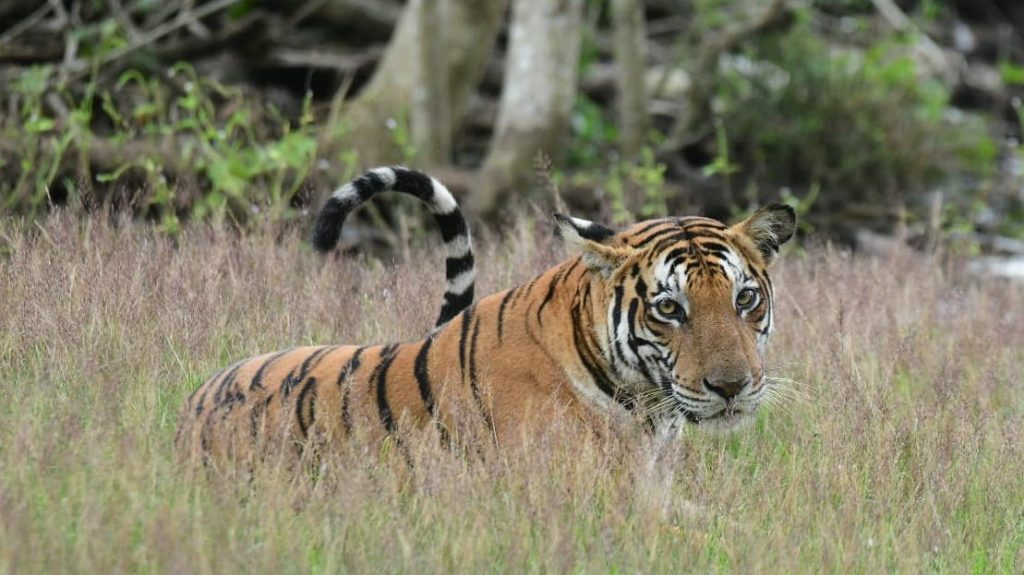Mysore Maharajas’ took early steps to protect Tigers, wildlife
3 min read

Ajith M K
Mysuru: India is celebrating the Golden Jubilee of Project Tiger this year. Prime Minister Narendra Modi will be taking part in the celebrations organised at Convocation Hall of Karnataka State Open University (KSOU) in the city on April 9.
However, amid this joyous moment, it calls for tracing the efforts of Princely Mysore State and Wadiyar rulers, who laid the foundation for conservation of tigers, a first of its kind in those times, that still continue to form the core of many conservation activities.

Mysuru was a model State during pre-independent India, as it had many firsts to its credit not just in the country, but also world.
Similarly, when it comes to Tiger conservation or wildlife conservation, the action began, with the introduction of Mysore Game and Fish Preservation Regulation II 1901, to protect the wildlife and forests for posterity. Kudos to the then Maharajas of Mysore the tenth Chamaraja Wadiyar and his son and celebrated ruler Nalwadi Krishnaraja Wadiyar, who took the step to protect the wild animals from extinction.

In the year 1892, the Tenth Chamaraja Wadiyar first started a Cage to save animals which were wounded in Shikar (hunting). Later, Maharaja Nalwadi Krishnaraja Wadiyar brought a Special Act with the sole intention towards wildlife conservation and listed birds and animals including Tiger, under the new law.
A Game Preserve Officer was appointed to monitor the whole of wildlife and its conservation aspects in policy making and enforcement.
D N Neelakanta Rao served as Game Preserve Officer in charge for many decades and his letter correspondence, preserved at the Department of Archives in Mysuru elaborates the facts and figures related to conservation of Tiger and other animals.

The Game Preserve Officer had written a letter to the Maharaja and conveyed to the royal the matter of 40 tigers killed in a snare game, which if continues the will make the population of big cats vanish from our forests. In 1932, the 35 sq.km area of the wild was marked as protected area for wild animals and later it was expanded and renamed as Venugopala Sanctuary, which was later rechristened as Bandipur National Tiger Reserve forest.
Tiger Preserve Budget
In 1931 the Game Preserve Officer wrote a letter to ADC of the Maharaja to sanction Rs 3,000 for maintenance of the Tiger Reserve. It clearly shows the commitment of Mysuru Maharajas regarding the protection of wild animals, particularly Tiger.

Tigers at Mysore Palace
Maharajas of Mysore were aware of Tiger and its importance and when they built a new palace (the existing Palace that is one of the prominent tourist attractions in the country) and installed eight bronze tigers at Palace precincts. Robert Williams Colton of Royal Academy of Arts, London sculpted these tigers in ferocious look in 1909, that has been a subject of many tourist photos and videos.
The Tenth Chamaraja Wadiyar, Nalwadi Krishnaraja Wadiyar and Jayachamarajendra Wadiyar, all the three Maharajas considered as rulers of modern Mysore have immensely contributed to the protection of tigers and wildlife in Mysuru region by drafting policies, even before the world realised the importance to save tigers.
In 1973, the Government of India took a noble step, alarmed after a report about declining numbers of Tiger in Indian forests was released.
Jim Corbett National Park in Uttarakhand was the first to be selected under Project Tiger in India. While in South India, Bandipur forest was the first to be selected under the project. Now, the area of Bandipur Tiger Reserve is spread over 912.04 sq.km of area, which gives a wider look into the fruitful efforts of tiger conservation.
Project Tiger has completed 50 years and the tiger population in Bandipur Tiger Reserve has increased, but continues to face existential threat, forcing them to stray out of the forest territory.
– Team Mysoorunews







